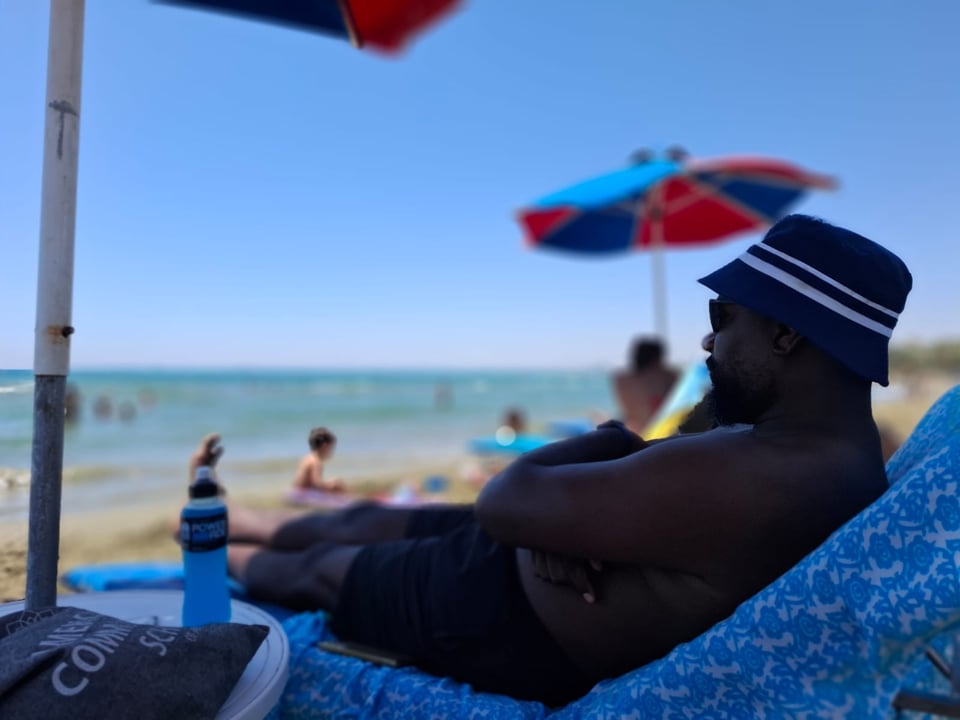Protect Ya Neck

After spending nights in roughly ten different beds this summer, I finally bring you greetings from Abu Dhabi once again.
We’re gonna open with two quick notes from the corrections department.
At the top of last week’s edition, I misidentified the capital of Cyprus as Larnaca, where we were visiting, rather than Nicosia. My bad. Thanks to reader NB for pointing that out.
Also in the last newsletter, I wrote about how I almost became a “bucket hat” guy. Well, that was a lie. I broke down and copped one after seeing a couple of older members of the Cypriot Bald Brotherhood with pretty nasty cases of skin cancer.

I bring up this whole bucket hat thing partly in jest, but I’ve been carrying some apprehension the last few weeks. On July 23, journalist Matt Driscoll passed away. He was an absolute pillar of the community in Tacoma and I eulogized him on a special episode of the podcast. I had texted him the prior Saturday and like much of the community was completely blindsided by his passing. To say “he leaves big shoes to fill” is such an incredible understatement. He’s irreplaceable. Every time I’ve thought of his passing since, I’ve gotten a bit choked up. Matt was about my age and this was another reminder that I, and maybe you, need to take care of our health. Get all those preventative screenings and various oscopies.
No one is as young as they used to be and tomorrow isn’t promised.
Okay, now onto the main event.
I’ve wanted to rant about this piece for months. I have no idea how it didn’t get a toehold in the zeitgeist.
This summer The Wall Street Journal (apologies for the paywall) published a brain melting piece, “The Influencer Is a Young Teenage Girl. The Audience Is 92% Adult Men.”
It’s an investigation into the culture of teen and tween influencers and their parents who, knowingly or otherwise, pimp them out to creeps online.
Influencer culture poses countless problems, but this story crosses into far more dangerous territory. It borders on negligence and endangerment. The potential for disaster was evident from the very beginning:
The mom started the Instagram account three years ago as a pandemic-era diversion—a way for her and her daughter, a preteen dancer, to share photos with family, friends and other young dancers and moms. The two bonded, she said, as they posted photos of the girl dancing, modeling and living life in a small Midwestern town.
The mom, a former marketing manager, oversaw the account and watched as the number of followers grew.
Listen, I have an Instagram account. It’s private.
If you want to follow me, you request to do so. I reject people all the time, mostly students (past & present) who stumble on it. Roughly half of accounts on the service are private. The most common reason to have a public Instagram is that you want to sell something to an audience. Now, go back and re-read that passage with that in mind. Who started the account? The mom. What’s her job? Marketing. What is the commodity? The child. Tell me I’m lying.
Photographers soon clamored to shoot professional photos of the girl to add to their portfolios, while brands scrambled to send her free apparel for modeling.
As you read it, it just gets worse and worse. In a later passage, the mom rationalizes sharing photos of her child through a special subscription account within Instagram best described as OnlyFans-light:
The Midwestern mom debated whether to charge for access to extra photos and videos via Instagram’s subscription feature. She said she has always rejected private offers to buy photos of her daughter, but she decided that offering subscriptions was different because it didn’t involve a one-on-one transaction.
“There’s no personal connection,” she said. “You’re just finding a way to monetize from this fame that’s impersonal.”
The content she started charging for was simply more of the types of photos and videos they posted free, but hundreds of accounts soon subscribed. Some were other young influencers. Many others were adult men.
Monetize from this fame? Subscription premium service? Private offers to buy photos? Bro, what?!
One of my crankiest takes and a reason that I retreated from Twitter is that I don’t think most human beings are morally developed enough to manage the responsibility of having a truly global reach. The incentives of influencer culture are driven by all the worst and grift-iest parts of this moment in history. It's an amazing way to get rich and lose your soul:
“I try to keep it girlie. I always have bows in my hair and cute stuff,” the daughter said. “Girls obviously want to see fashion inspiration and hairstyles. I also never post in swimsuits, ever….”
Still, the mom realized she couldn’t stop men from trading the photos, which will likely continue to circulate even after her daughter becomes an adult.
The reporter then went on to describe the lecherous chat rooms where dudes swap images from accounts like this Instagram on encrypted chat apps. I can’t even with any of this.
I am not a parent. I am extremely happy about that.
I also absolutely can’t fathom the cascading societal failures at play here: the desire to turn your child into a brand, Instagram's lax moderation and terms of service, and the creepers in the chat rooms being near the top. I commend the reporter, Katherine Blunt, for covering this. I have no idea how she didn’t reach across the internet and shake the parents she interviewed for the story. The anger I felt in reading all this stayed with me for months.
This isn’t my first time diving into the cultural impacts of Instagram, if you want to hear more, here’s my conversation with Sarah Frier, author of No Filter.
If you have access to the Journal you have to give this story a read.
I’ll be back next week with some reflections on the start of my nineteenth year of teaching.
As always, if you have any thoughts or feedback about the newsletter, I welcome it, and I really appreciate it when folks share the newsletter with their friends.